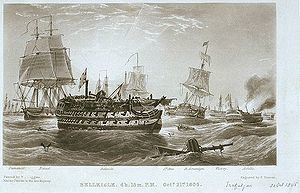Laid down August 1791 as Lion Launched 29 April 1794 Weight 2,966 tons | Commissioned June 1794 Length 56 m Beam 15 m | |
 | ||
Renamed Marat on 28 September 1793Formidable on 25 May 1795 | ||
Lion was a Téméraire class 74-gun third rate ship of the line of the French Navy, which later served in the Royal Navy. She was named Lion on 23 April 1790 and built at Rochefort from August 1791 until June 1794. She was renamed Marat on 28 September 1793 (7 months before being launched) and then Formidable on 25 May 1795, with the changing fortunes of the French Revolution.
Contents
- Capture in the Battle of Groix
- Battle of Trafalgar 1805
- Danish West Indies 1807
- Channel Fleet
- References
She took part in the Action of 6 November 1794, managing to rake HMS Alexander.
Capture in the Battle of Groix
Fighting under captain Linois on 23 June 1795 at the Battle of Groix, she was captured by HMS Barfleur near the French port of Lorient. She was taken into service in the Royal Navy, but because the Navy already had a Formidable, she was renamed Belleisle, apparently in the mistaken belief that she had been captured off Belle Île, rather than the Île de Groix.
Battle of Trafalgar 1805
Captained by William Hargood, she was the second ship in the British lee column at the Battle of Trafalgar in 1805, and as such was engaged by the Franco-Spanish ships Achille, Aigle, Neptune, Fougueux, Santa Ana, Monarca and San Juan Nepomuceno. She was soon completely dismasted (the only British ship which suffered that fate), unable to manœuvre and largely unable to fight, as her sails blinded her batteries, but kept flying her flag for 45 minutes until the British ships behind her in the column came to her rescue. With 33 dead and 93 wounded, she was then towed to Gibraltar after the battle by the frigate HMS Naiad.
Danish West Indies 1807
Following the concern in Britain that neutral Denmark was entering an alliance with Napoleon, the Belleisle sailed as the flagship of Rear-Admiral Alexander Cochrane, who commanded the squadron of ships that was sent to occupy the Danish West Indies. The squadron, which included HMS Prince George, HMS Northumberland, HMS Canada, HMS Ramillies and HMS Cerberus, captured Telemaco, Carvalho, and Master on 17 April 1807. The actual occupation of the Danish West Indies did not occur until December, after receipt of news of the second battle of Copenhagen.
Channel Fleet
From 1811 she was in Portsmouth harbour, and in 1814 the decision was taken to have her broken up.
